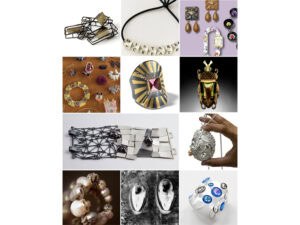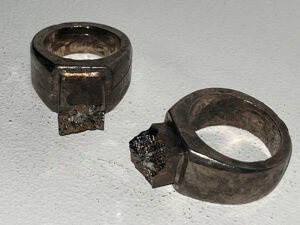In her article on the closing of Galerie Louise Smit, jewelry historian Liesbeth den Besten painted a rather unflattering picture of the contemporary jewelry market and what she feels is an unbalanced relationship between galleries and artists. In this unregulated market, den Besten writes, the odds are tipped in favor of galleries, which sometimes make unjustifiable claims on artists and offer few or no guarantees in exchange. Citing the mounting pressures exerted on makers, den Besten ends her article with an appeal to galleries for more transparency, more accountability, and—why not—a charter of fair conduct between galleries and artists.
The letter below is Stefan Friedemann’s answer to Liesbeth den Besten.
Dear Liesbeth,
A healthy and respectful cooperation between gallery and artist is based on communication of shared goals, honesty, and effort (and expenses) from both sides. I respect that you have heard many artists vent their frustration, but if there is a healthy relationship between gallery and artist, a contract is not necessary.
You make the point that the gallery owner must bear the risk, expense, and effort because “this is business,” but you fail to mention that being an artist is also a business. The artist is not born as such, but makes a decision to become one. Some handle their business very professionally. Many do not. You stated that it would be naive to think that if an artist is unhappy they can find another gallery. On the contrary, to think this is not naive. It is a daily occurrence. If the artist is a good artist, he will find another gallery quickly. Maybe not in his home city or region, but this doesn’t really matter anymore. If he does not handle his business of art in a professional or ethical manner, finding a new gallery may prove to be more difficult.
It is true that the arrangement between artist and gallery promises no guarantee of sales. This is, of course, difficult for the artist and for the gallery. These sales are what keep galleries functioning. Meanwhile, galleries are expected to challenge viewers with complex work (which is often difficult to sell), and in fact, the more interesting galleries rarely make commercial viability the main criterion for deciding to represent an artist. If they did, there would be a considerable drop in exhibition quality around the globe.
Arrangements between different artists and different galleries vary, often based on the quality of the work, the efforts and expenses the gallery makes to promote the work, the cost of artists’ materials, and so forth. There are surely horror stories to be told from both sides, but from my experience, the gallery is often very flexible and allows the artist to set the terms of their reciprocal relationship. In fact, as the artist has more galleries representing his work and selling it to an international market of the same clients, the gallery has very little choice in this discussion.
I would argue that, in our field, much power lies with the artists, and that they very seldom hand those powers over to the gallery. They own the work and can take it to another venue regardless of how or where the gallery has been promoting it. In actuality, it is only when a (good) artist begins to relinquish some of these powers—giving exclusivity to a body of work, for example—that the gallery can envision the possibility of earning more from the artist’s work, afford to take further risks, investigate new avenues of promotion, and promise more effort on behalf of the artist. Of course, the gallery can’t make the same effort for every artist. Some are simply making more important work at a particular time, or the work may just fit with the gallery program in a certain way and not in another. If the relationship is not working for the artist or the gallery, a change can and should be made.
You stated that, in this market, “the galleries are almost forced to exhibit at fairs,” and you fairly ask if this is a good development or not. In order to meet clients and make sales, many galleries must participate in these events, but another fact is that most artists want their work to be in these fairs. In most cases, if a gallery does not show at a fair, the artist will exhibit with another gallery that does. This being the case, doesn’t it make sense that artists accept this “shift in investment” from the individual to the fairs and also understand that this is a “production cost” the gallery shoulders? (More on this soon.)
As mentioned, galleries are often very flexible regarding the artist’s material costs, in most cases because they are not given any choice in the matter. If an artist tells you she has invested heavily into materials and should therefore earn a disproportionate percentage of the selling price, what choice do galleries have? Raising the gallery price is not really an option. Our clients are traveling around the globe, in person and on the web. They are seeing the same work by the same artists in other galleries. Overpricing would be a quick way to lose the trust of our clients that we have worked hard to build. Do you ever hear an artist offering flexibility due to the gallery’s “production costs?” Not all galleries make the same investments. Those that do put themselves out at SOFA, Collect, or the vastly more expensive fairs, such as Miami and Basel, bear the risk of not earning any money or even losing quite a bit at these events which, aside from money, also take enormous energy. If Ornamentum exhibits in Miami or Basel, the artists who sell work there earn from these events (sometimes a little, sometimes a lot) regardless of whether the gallery makes a profit, breaks even, or loses money. Is the cost of the fair not a “production cost?” From your statements, I imagine that you would be shocked if a gallery asked an artist to pay a portion of these costs, wouldn’t you? But why would this not be a fair question to ask? What about the insurance, credit card fees, rent, advertising, mailings, and other costs of keeping the gallery running? Are these not “production costs?”
I imagine your answer is “this is business.” I accept that, but again, being an artist is also about owning a business. If I run my business badly, I do not survive. If an artist runs their business badly, is it the gallery’s fault?

Regarding your comment about having contracts modeled on the ones you imagine exist in the high-priced art world: We are blessed to have one of the world’s important art gallery owners as a client and good friend. When we had trouble with an artist last year, I discussed the topic of contracts and lawyers in the artist/gallery relationship with him. In his 35-year career handling major figures in contemporary art, some with worldwide exclusivity, he has never had a contract other than trust. I was amazed. “The artists own the work and can take it back whenever they choose,” he said. “A contract can offer no safety to the gallery, and if there isn’t a basis of trust between the artist and gallery, a contract isn’t going to create it.”
In the end, the thing that will strengthen our field is bringing new collectors into it. In contrast to the fine arts, the jewelry that is most sought after and sets record prices is, sadly, mostly work by dead artists. In this case, dealers have some control over when a piece of jewelry will be offered for sale and for how much, and the owners of the work are happy to be able to resell it at a higher price than they paid.
Instead of starting the conversation on the premise that artists are mistreated by galleries—which is, most often, not the case—the conversation should be about how the artist/gallery relationship can be strengthened and how the shared goals of the artist and gallery can be implemented by developing shared strategy for a long term relationship.




